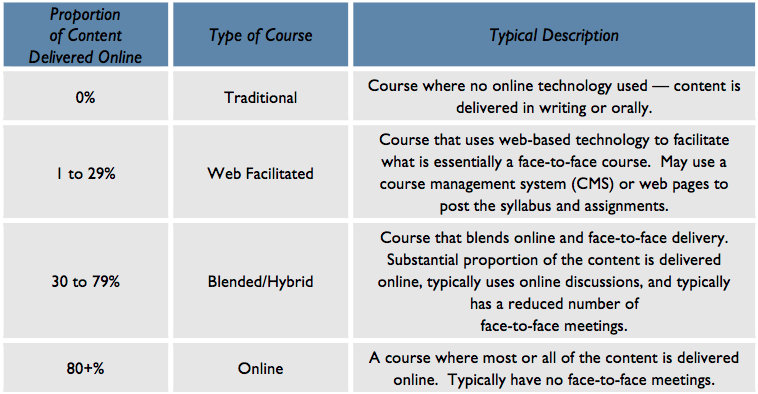
Consider the following questions:
- What is the online environment that you will be using?
- How does an online environment compare to a classroom environment?
- What limitations does an online environment impose?
- What advantages are there (for students and instructors) when you teach and learn in an online environment?
The short answer is… it depends. There is no single model for an online course. Rather, online courses differ a great deal depending on the desired learning outcomes, the pedagogy, the subject matter, as well as the technology and tools employed in the course.
There are different models for teaching and learning online, and there’s a wide range in terms of how much occurs in the online environment. In this section you can review some of these models (and how they overlap and connect).
Think about a course you have taught and where it would fit in this matrix – are you already teaching a web-facilitated or blended course?

Changing Course: Ten Years of Tracking Online Education the United States; I. Elaine Allen and Jeff Seaman, January 2013.
Note: The authors defined the percentages of content delivered online for their research purposes; those numbers may vary by institution, and across the literature in this field of research.
Types of Online Courses
In this course the focus is on how to design, develop and facilitate asynchronous, collaborative courses that will be completely online. However, there are many other ways that technology is integrating into higher education programs, and there is sometimes confusion in discussing and defining various types of courses.
Asynchronous (anyplace, anytime) and synchronous (anyplace, same time) are terms that may be heard in any discussion about online education. They refer to modes of communication in which people can interact online, bridging distance and, in some cases, time.

Asynchronous collaborative online courses
- Anyplace, anytime.
- People can participate from any computer/mobile device with an Internet connection, and they can participate at times convenient to them.
- Good for self-motivated, independent students; also for students who have complicated schedules (working, parenting, interning, dual-degree, etc.)
- A typical online course will have no face-to-face interaction among students and their instructor(s).

Asynchronous self-paced courses
- Anyplace, anytime.
- Sometimes called “online anytime” courses; these courses allow students to start and finish completely on their own schedule and generally do not require online collaboration with other students.
- Good for self-motivated, independent students; also for students who have complicated schedules (working, parenting, interning, dual-degree, etc.)
- A typical online course will have no face-to-face interaction among students and their instructor(s).

Synchronous online courses
- Anyplace, same time.
- People can participate from any computer with an Internet connection. However, they must all log in at a particular time, such as 3:00 p.m. on Tuesday afternoons.
- Some online courses use video-conferencing or web-conferencing to meet for regular class sessions.
- Good for students who can meet fixed schedule requirements, also for students who want more immediate verbal interaction with instructor and peers.

Blended or hybrid courses (includes flipped classrooms)
- Blended—also known as hybrid—courses are scheduled courses that combine synchronous meetings in a classroom (face-to-face) and asynchronous learning online (reviewing content, participating in online group activities, etc.).
- Flipped courses are another variation of the blended course in which the typical lecture and homework elements of a course are reversed.
- There are several models and definitions for blended courses, but they assume “that certain activities can be better accomplished online, either individually or in small groups, than in a class.”

Massive open online courses (MOOCs)
- A MOOC is an online course aimed at large-scale participation and open access via the web.
- These courses attract world-wide audiences, may have thousands of students, and are offered for free (or sometimes for a very low cost for a certificate).
- More information is available at the Educause Library’s web page about Massive Open Online Courses.
- For more about UW-Madison’s teaching and learning with MOOCs go to the Education Innovations page.
Asynchronous Courses & Scheduled Events
Asynchronous courses are the most common, but as technology has advanced, new tools have allowed real-time (synchronous) collaboration. Some (mostly asynchronous) online courses do include several (1-3) meetings for an orientation, to answer questions, and to proctor exams.
Keep in mind that many students take online courses so they can learn anywhere at any time. It is important to have sound pedagogical reasons for using synchronous communication and to understand the benefits and challenges for student communication, lectures, or group activities.
- Most asynchronous courses in higher education have a defined course schedule, with due dates for assignments and activities. Students are expected to interact with their instructors and classmates and move through the course in a cohort.
- Some asynchronous courses are truly “online anytime” or self-paced, and students can navigate through the content, completing it at their own pace. Students in these courses work independently and may have minimal interactions with other students.
References:
- Allen, I. E. & Seaman, J. (2013). Changing Course: Ten Years of Tracking Online Education in the United States. Babson Park, MA: The Babson Group. Retrieved from http://sloanconsortium.org/publications/survey/changing_course_2012